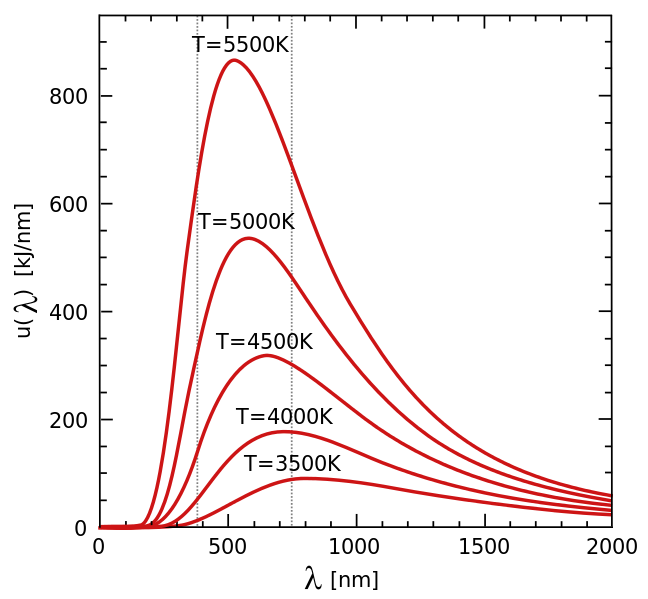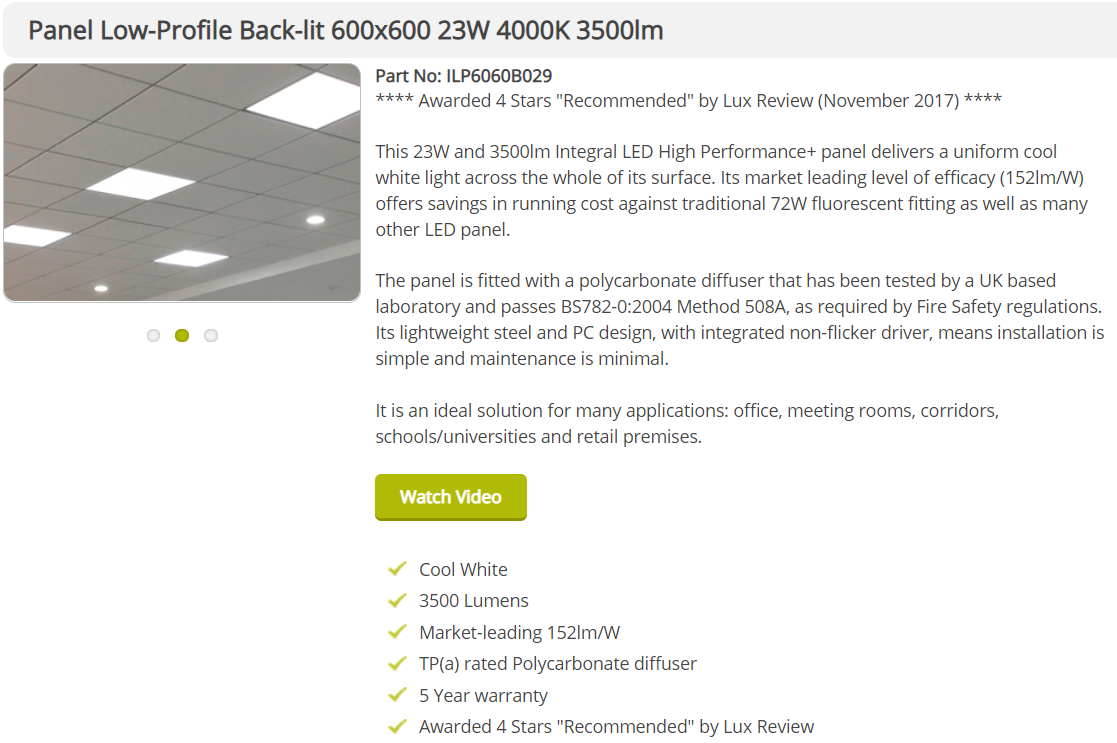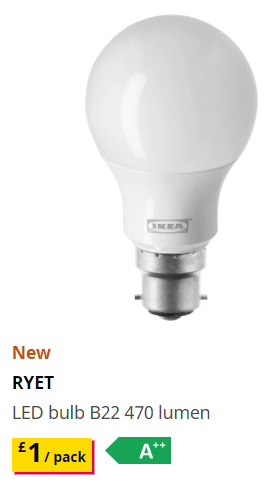Where do we get light from?
In the beginning there was only one source of light – the light from the sun. That light is electromagnetic radiation, emitted by the sun, a very hot body. At first all artificial light sources mimicked the sun because they, too, were produced by hot bodies – by fires, by burning oil or burning candle wax. Then along came electricity which also mimicked the sun by passing an electric current through a wire to make the wire hot enough to give light out.
Light output of lamps
A most important quality of a lamp is how much light it gives out. We are not, yet, very much used to measuring the light output of lamps. In really quite recent days we all bought the same type of lamp, the hot wire lamp, called an incandescent lamp. We used to measure the brightness of a lamp by the power we supplied to it. An average sort of brightness was a 60 W bulb. A much brighter bulb was 100 W and a dim one perhaps 40 W or even 25 W.
Nowadays, with different types of lamps needing different powers, we need a unit that tells the actual light given out. That unit is the lumen. The old 60 W lamps gave out about 800 lumens. A brighter 100 W lamp gives out about 1500 lumens and a 40 W lamp about 500 lumens.
You know that hot bodies used for lighting are white hot. The white light they give out isn’t a single colour. It’s made of a spectrum of colour, with light from deep red to violet. To see properly we need light of all the different colours. That’s why we use white light for lamps.
Luminous efficacy
The luminous efficacy of a lamp tells you how much light you get out (in lumens) per watt of power you put in. Lamps with a higher efficacy give you more lumens per watt. It is as simple as that. The old-fashioned tungsten filament incandescent lamp gave out about 800 lumens (800 lm) for an input of about 60 watts (60 W);
that is (800 lm)/(60 W) = 13 lm/W or 13 lumens per watt.
The most efficient light would be yellow-green
The eye is the most sensitive to this yellow-green light which has a wavelength of 555 nm. It’s this sort of colour.

You can refer to this site if you want to see the colour of different wavelengths of light.
https://academo.org/demos/wavelength-to-colour-relationship/
A lamp that gave out light of only this yellow-green colour would be the best for brightness. If you had a device that converted all its input power into light at that yellow-green wavelength, you’d get a luminous efficacy of 683 lumens per watt. That means that, if you were happy with yellow-green, you could have a light bulb, roughly the equivalent of an old 60W bulb, needing only 1 W to power it. Of course that would be bright but it wouldn’t be any use for many purposes because everything would look strange different shades of yellow-green. What we need is a white light that has a range of colours in it, even if our eyes are not as sensitive to other colours.
Hot bodies produce a whole range of radiated energy, only some of which is visible.
Let’s have a look at the range of wavelengths of electromagnetic radiation given out by a hot body. A hot body near the melting point of tungsten (3695K) produces some light at 555 nm and the rest over other parts of the electromagnetic spectrum including lots of UV and IR.

A black body at the temperature of melting tungsten, somewhere between 3500 K and 4000 K, giving all its input out by electromagnetic radiation (that means no energy conducted out through the connecting wires, etc), could have an efficacy of 55 lm/W. That’s a lot more than the efficacy of the old fashioned 60 W hot-wire light bulbs which we calculated had an efficacy of 13 lm/W. That’s because it has to operate at a temperature much lower than the temperature at which its filament would melt.
If you could find a material that would survive being run 7000 K, twice the melting point of tungsten, hotter than the surface of the sun, that light could give out 95 lumens for each watt input, an efficacy of 95 lm/W. For many years, and still now in some cinemas and sometimes in lighthouses, arc lights are used. These make use of extended sparks through a gas from one terminal a lamp to another. So the ‘filament isn’t a solid that could melt, it is a gas.
LED lamps avoid giving out light you can’t see.
Modern lamps are made with Light Emitting Diodes (LEDs). LEDs use a different technique to make a high efficiency light bulb. With LEDs you can build a device that only gives out the light you can see, so it doesn’t waste electricity giving out ultraviolet or infra red light. If you chop out the hardly visible colours but otherwise mimic a black body spectrum (the temperature of which doesn’t change the figures much) you can get 250 lumens of light out for each watt of electricity input.
If you reduce the spectrum of your light, so your LED does not give out light where the sensitivity is down to 5% of the maximum, you can get and even higher luminous efficacy – 350 lumens for each watt, though obviously your light doesn’t show colours so well. We say that there is some deterioration of colour rendering. If you keep light down to the 2% threshold, you can get an efficacy about 300 lm/W with reasonable colour rendering.
Back to the beginning and the extreme, if you only give 555 nm light out, you could get to 683 lm/W.
The best available lamps nowadays.
The best lights I have seen so far for domestic lighting are ones like these sold by Argos for £2.50 each.

This Argos lamp gives 806 lumens for 6 watts of input, which is 134 lm/W.
Do you remember from the beginning where I said that a 60 W lamp gives out about 800 lumens? The Argos LED lamp gives out the same light as an old-fashioned lamp but only use 6 W instead of 60 W. Its efficacy is ten times more than that of a hot wire lamp.
Here is a brighter lamp.

This lamp gives out 1521 lumens for an input power of 12 W.
That is 1521/12 = 127 lumens per watt. This lamp is available from mygreenlighting.co.uk and is also dimmable.
https://www.mygreenlighting.co.uk/replacement_bulbs/round_bulbs/bayonet_bc_b22/10527.html
The energy balance for a lamp
We’ve just said that the maximum theoretical efficacy you can get for any lamp is about 300 lumens per watt. At the theoretical limit, all the energy coming out of the lamp would be electromagnetic radiation tailored to match a hot-wire lamp but with the spectrum trimmed to cut of light outside the visible spectrum that had no lighting effect.
Just imagine a perfect bulb gving out a curtailed spectrum of 806 lumens with an efficacy of around 300 lm/W.
That lamp would be giving out
(806 lm)/(300 lm/W) = 2.7 W of light.
So a perfect 800 lumen lamp would need 2.7 watts. The Argos lamps above takes in 6 W to give out 2.7 W of light, so they are wasting 3.3 W, which is being given out as heat.
Let’s compare that with an old 60 W tungsten lamp which also gave out about 800 lumens. The hot-wire tungsten filament lamp used to give out the same 2.7 watts of light as the LED lamp. But it was taking in 60 W.
So it is giving out 60 W – 2.7 W = 57.3 W of heat.
It’s not surprising that the old tungsten lamps were hot – taking in 60 W of light, giving out 57.3 W of heat and only 2.7 W of light.
How far is there to go?
Heating effects of currents in wires and semiconductors are bound to limit efficiencies, let’s say to 70% of theoretical. That means that we could guess that the maximum efficacy a lamp could get might be about 200 lumens per watt. It certainly couldn’t be more than 300 lumens per watt.
IntegralLED, who make the 1521 lumen lamp mentioned above, have a ceiling panel lamp that has an efficacy of 152 lumens per watt.

https://integral-led.com/products/panels/panel-low-profile-back-lit-600×600-23w-4000k-3500lm
The vendor of LED lamps at this website says that some of its products have efficacies of up to 170 lm/W.
https://hitlights.com/blogs/news/efficaty
So LEDs are well on towards the efficiency that any lamp could possibly have. What this means is that the 60 W, or should I say 800 lumen, lamp which you can buy at Argos for £2.50 and consumes about 6 W could, with today’s technology, be made to need only 5W. In the future we could see that dropping to 4W or so, but the theoretical limit is to something over 3W.
More efficient lighting is the main reason our electricity production has reduced.
The number of homes and the number of people in the UK have steadily increased over the years. Yet the amount of electricity used for lighting has gone down by a third since 1997. Here you can see how the amount of electricity generated has decreased over the past thirty years.

The UK population rose from about 58 million in 1997 to about 68 million today. With more people, more homes and more electrical appliances, electricity supplied grew, as you can see from the graph above. But less electricity was needed after 2005. This is because about a quarter of our electricity supply was used for lighting, and now that lighting is much more efficient, we don’t need so much electricity.
What will lamp manufacturers sell when we all have LED lamps?
The Argos lamp referred to above has a quoted life of 15,000 hours and 100,000 switching cycles. That light should last 10 years at 4 hours a day. This Ryet bulb from Ikea has a lower luminous efficacy. It gives out 470 lm for an input of 4.5 watts; that’s 104 lm/W. But it only costs £1.

It’s the ultimate consumer product: costs nothing to buy, nothing to run, needs no maintenance and lasts for ever. But what will lamp manufacturers sell when we all have LED lights. For a while they can persuade us to trade up to ever more efficient lamps but there is not much saving left to be made. After all, the 60W lamp we used to buy only uses 6W now and could never use less than 3 W.
Perhaps then the manufacturers will make LED lamps that fail early. After all, that’s what they do with cars. Cars could be designed to last for twenty years or more but instead they are designed to fail in 8 to 10 years so we go out and buy new ones.
In 1971 I had a tour of the physics department of Durham university. They showed me a new component. ‘It’s a diode really but it gives out light when it conducts. It’s called a light emitting diode or LED for short. We think it might be useful.’